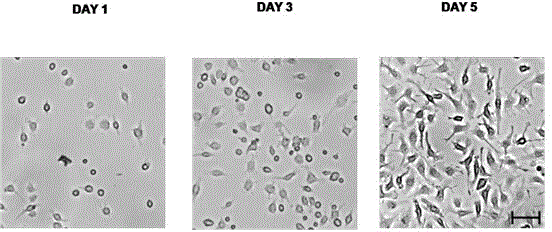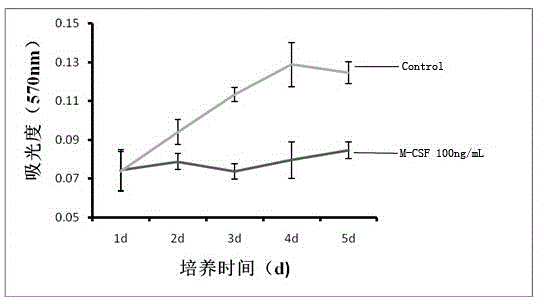Method for extracting myelomonocyte and differentiating to osteoclast
A mononuclear cell and osteoclast technology, applied in the direction of bone/connective tissue cells, animal cells, vertebrate cells, etc., can solve the problems of immature osteoclast cell lines, unclear mechanism, and difficulty in obtaining
- Summary
- Abstract
- Description
- Claims
- Application Information
AI Technical Summary
Problems solved by technology
Method used
Image
Examples
Embodiment 1
[0029] Example 1 Observation of morphological characteristics of bone marrow mononuclear cells, identification of surface antigens and drawing of growth curves
[0030] Remove the bilateral femurs and tibias of C57BL / 6 mice under aseptic conditions; cut the metaphysis in an ultra-clean platform, and use a 5 mL sterile syringe to withdraw serum-free α-MEM medium to gently rinse the bone marrow cavity 4 times; 100um cell filtration After filtration, centrifuge at 1200 rpm for 5 minutes, discard the supernatant; add 10 times the cell volume (5 ml) of sterile 1X red blood cell lysate, gently pipette to mix, lyse on ice for 5 minutes, centrifuge at 1000 rpm for 5 minutes, discard the red supernatant To remove red blood cells; resuspend the pellet in serum-free α-MEM medium and wash it twice. Resuspend the bone marrow cells in 5 mL of α-MEM culture medium containing 10% fetal bovine serum and 100 U / mL antibiotics, and inoculate it on 25 cm 2 In a plastic culture flask, at 37℃, 5%...
Embodiment 2
[0041] Example 2 Identification of differentiation of bone marrow mononuclear cells into osteoclasts
[0042] The cell isolation and culture methods are the same as in Example 1. The primary bone marrow mononuclear cells in the logarithmic growth phase are scraped off with cell scraping, and the size is 1×10 4 cm 2 The density is passaged in a 12-well culture plate and placed in an incubator (37 ℃, volume fraction 5% CO 2 ) Cultivate for 4-6 days, the control group and the induction group each have 3 wells. The control group is added with 20ng / mL M-CSF, and the induction group is added with 20ng / mL M-CSF and 100ng / mL RANKL, which are changed every 2 days liquid.
[0043] 1. Osteoclasts were induced and cultured for 4-6 days. TARP staining was performed when obvious multinucleated fused osteoclasts were observed under the microscope. The cells were fixed with 4% paraformaldehyde for 20 minutes at room temperature, and then treated with naphthol AS-BI phosphate. Incubate at 37°...
PUM
 Login to View More
Login to View More Abstract
Description
Claims
Application Information
 Login to View More
Login to View More - R&D
- Intellectual Property
- Life Sciences
- Materials
- Tech Scout
- Unparalleled Data Quality
- Higher Quality Content
- 60% Fewer Hallucinations
Browse by: Latest US Patents, China's latest patents, Technical Efficacy Thesaurus, Application Domain, Technology Topic, Popular Technical Reports.
© 2025 PatSnap. All rights reserved.Legal|Privacy policy|Modern Slavery Act Transparency Statement|Sitemap|About US| Contact US: help@patsnap.com



